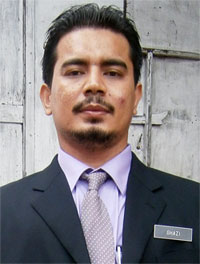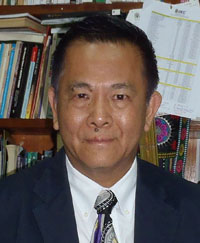Journal of Geography and Earth Science, 1(1), 01-08
Abstract
Problem Statement: Landfill site at Kg. Teluk Kitang were fully utilized in around 14 years ago. The method adopted was not fit a right landfills which do not have the bottom of the landfill liner. In the absence of this liner layer leachate seepage occurs causing so bad. The presence of leachate into the soil can interfere with clean groundwater can cause heavy metal content increased and could endanger the human health of a long period of time. Removal of heavy metals such as Iron (Fe2+), Copper (Cu2+) and Zinc (Zn2+) from leachate was studied using granular activated carbon, fly ash, limestone and granular activated carbon mixture. Methods: The adsorption isotherm is an equilibrium test group will provide data for the substance adsorbed per unit weight of adsorbent to adsorbent amount remaining in the sample solution. The graph shows the adsorption isotherms of metal removal studied by looking at the coefficient of determination, R2. The slope of the linear plot line is also a good and suitable for testing by group. Kf value and 1 / n is obtained from the equation of linear plotted by comparing the equation obtained by the equation given. Value of 1 / n can be obtained from the slope and Kf values obtained with the antilog value of log Ce. Results: Of the isotherm plots, note the value of Kf, R2 and 1 / n for Iron metals are 0.53371, 0.9842 and 0,988, for zinc 3.0123, 0.8974 and 1.7461 and copper are 0.7227, 0.3867 and 0.0791. Conclusion: These values indicate the removal of the best metal to use GAC is for iron and zinc metal to have a better adsorption capacity (Kf value is greater).
Full Text: PDF
Ghazi et al. (2013). Freundlich Isotherm Equilibrium Equastions in Determining Effectiveness a Low Cost Absorbent to Heavy Metal Removal In Wastewater (Leachate) At Teluk Kitang Landfill, Pengkalan Chepa, Kelantan, Malaysia. Journal of Geography and Earth Science, 1(1), 01-08
Evanko CR, Dzombak DA (1997). Remediation of Metals-contaminated Soils and Groundwater, Technology Evaluation Report, TE-97e01. Ground-Water Remediation Technologies Analysis Center, Pittsburg, PA.
Hamidi Abdul Aziz Mohd Suffian Yusoff, Mohd Nordin Adlan, Nurul Hidayah Adnan and Salina Alias,Physico-chemical removal of iron from semi-aerobic landfill leachate by limestone filter.Pages 53-64.
Masters GM (1998). Introduction to Environmental Engineering. 2nd ed.Upper Saddle River, Prentice Hall, NJ.
Nery JRC, Bonotto DM (2011). 210Pb and composition data of nearsurface sediments and interstitial watersevidencing anthropogenic inputs in Amazon River mouth, Macapá, Brazil. J. Environ.Radioactivity, 102: 348-362.
Removal of heavy metal ions from aqueous solutions using various low-cost adsorbents Journal of Hazardous Materials, Volume 102, Issues 2-3, 29 August 2003, Pages 291-302 Yuen-Hua Wang, Su-Hsia Lin and Ruey-Shin Juang
 Mohammad Ghazi bin Hj Ismail is a PhD student of environmental and water management at University of science Malaysia. His fields spans both geography and environmental sciences. At the University of science malaysia, engineering campus he earned an B.Eng. (Hons) in Environmental in 2006 and an Master of Science in Environmental in 2012. Subsequently, he aspect to received a Ph.D. in Environmental and water management (hidrology) from university of science malaysia in end of 2014.
Mohammad Ghazi bin Hj Ismail is a PhD student of environmental and water management at University of science Malaysia. His fields spans both geography and environmental sciences. At the University of science malaysia, engineering campus he earned an B.Eng. (Hons) in Environmental in 2006 and an Master of Science in Environmental in 2012. Subsequently, he aspect to received a Ph.D. in Environmental and water management (hidrology) from university of science malaysia in end of 2014.
Mohammad ghazi’s research interests lie at the intersection of geography and environmental science, specifically focussing on climatology, water resources and environmental management. He is currently PhD Student of the Section Geography, School of Humanities University of science Malaysia, Graduate Member Board of Engineer Malaysia, Graduate Member Institution of Engineers Malaysia, Member of Malaysia Water Association and ASEAN Engineer. He has published 1 book chapters and more than 7 articles in professional journals in the area of waste water engineering, water resources management and environmental management.
 Ngai Weng Chan is a professor of Physical Geography at Universiti Sains Malaysia. His career spans both geography and environmental sciences. At the University of Malaya, Kuala Lumpurhe earned an B.A. (Hons) in Geography in 1977 and an M.A. in Climatology and Meteorology in 1981. Subsequently, he received a Ph.D. in Environmental Hazards Management from Middlesex University (London) in 1995. Prof. Chan went on to do a Visiting Professorship at the Department of Geography, Memphis University (USA) in 2000/2001 and a Visiting professorship at the Asian Institute of Technology (Bangkok, Thailand) in 2006/2007. He taught subjects such as Physical geography, Climate and Weather and Urban Environmental Management in both universities.
Ngai Weng Chan is a professor of Physical Geography at Universiti Sains Malaysia. His career spans both geography and environmental sciences. At the University of Malaya, Kuala Lumpurhe earned an B.A. (Hons) in Geography in 1977 and an M.A. in Climatology and Meteorology in 1981. Subsequently, he received a Ph.D. in Environmental Hazards Management from Middlesex University (London) in 1995. Prof. Chan went on to do a Visiting Professorship at the Department of Geography, Memphis University (USA) in 2000/2001 and a Visiting professorship at the Asian Institute of Technology (Bangkok, Thailand) in 2006/2007. He taught subjects such as Physical geography, Climate and Weather and Urban Environmental Management in both universities.
Prof Chan’s research interests lie at the intersection of geography and environmental science, specifically focussing on climatology, water resources and environmental hazards management. He is currently Deputy Dean (Student Affairs & Networking) of the School of Humanities Universiti Sains Malaysia, Vice-President of International Water Resources Association (IWRA) and President of Water Watch Penang. He has published 26 books, 59 book chapters and more than 100 articles in professional journals in the area of climatology, water resources management and environmental hazards management. Recent awards include Fulbright Scholar Programme (2000-2001), “Outstanding Researcher of School of Humanities USM 2007” and Winner of Asia Water Management Excellence Awards 2010 Individual Category (National). Prof Chan is on the editorial board of Water International, International Journal of Asia Pacific, Malaysian Journal of Environmental Management, Iranian Journal of Environmental Health Science & Engineering and several other professional journals.
Haliza Abdul Rahman
Department of Environmental & Occupational Health
Faculty of Medicine and Health Sciences
Universiti Putra Malaysia
43400 Serdang, Selangor, Malaysia.
Nor Azazi Zakaria
River Engineering and Drainage Research Centre (REDAC),
Universiti Sains Malaysia, Engineering Campus
Seri Ampangan, 14300 Nibong Tebal
Seberang Prai Selatan, Penang
Malaysia
Browse Journals
Journal Policies
Information
Useful Links
- Call for Papers
- Submit Your Paper
- Publish in Your Native Language
- Subscribe the Journal
- Frequently Asked Questions
- Contact the Executive Editor
- Recommend this Journal to Librarian
- View the Current Issue
- View the Previous Issues
- Recommend this Journal to Friends
- Recommend a Special Issue
- Comment on the Journal
- Publish the Conference Proceedings
Latest Activities
Resources
Visiting Status
| 142 | |
| |
552 |
| |
3789 |
| |
9144 |
| 1082178 | |
| 3 |
 The Brooklyn Research and Publishing Institute
The Brooklyn Research and Publishing Institute